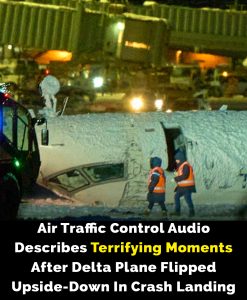On February 18, what was supposed to be a routine landing at Toronto Pearson International Airport turned into a terrifying ordeal for the passengers of Delta Air Lines flight 4819. The jet, originating from Minneapolis and carrying 76 passengers and four crew members, crashed during landing, flipped onto its back, and caught fire—leaving many in shock and others seriously injured. New audio from air traffic control is shedding light on what happened in those intense moments.

The passengers expected an ordinary conclusion to their journey, but what they experienced was anything but normal. As the aircraft descended for landing at Canada’s busiest airport, reports from those onboard and on the ground noted unusual turbulence. Then, disaster unfolded in seconds. The plane made a hard landing on the runway, skidded violently, and then flipped over, ending up upside down with its fuselage badly damaged and partly engulfed in flames.
Eyewitnesses and passengers described a terrifying scene. The Associated Press reported that the aircraft lost its right wing in the crash. Inside the cabin, chaos reigned. Passengers found themselves dangling upside down, strapped into their seats as smoke began to fill the plane. The surreal and horrifying scene left many clinging to hope and desperately waiting for rescue crews to arrive.
John Nelson, one of the passengers on board, shared his account with CNN. He recalled the flight being fairly uneventful until the moment the plane hit the ground. “It hit super hard, went sideways, and then there was a big fireball on the left side,” he explained. “When we came to a stop, I was upside down, just like everyone else.” Nelson managed to unbuckle himself and get out of the overturned plane. “I just tried to get out of there as quickly as possible,” he said. “Luckily, the firefighters got to us fast.”
Another passenger, Pete Koukov, compared the sensation to hanging upside down like bats. “We were sideways, and then suddenly, we were upside down,” he described. “It was terrifying.”
Emergency responders acted quickly, arriving on the scene within minutes of the crash. Rescue teams worked tirelessly to pull passengers from the wreckage as smoke poured from the fuselage. Of the 80 people onboard, 18 were injured. Three of them were reported in critical condition, while others suffered burns, fractures, and head injuries.
#BreakingNews: This is air traffic control recordings of Delta Air Lines Flight 4819 which crashed and overturned while landing at Toronto Pearson Intl. Airport today.
The Toronto Tower warned of high winds and a “slight bump” upon landing. pic.twitter.com/DHDeBi5IQN
— Gage Goulding – KPRC 2 (@GageGoulding) February 17, 2025
Shortly after the crash occurred at around 2:15 p.m., audio captured by LiveATC.net, a website that monitors and archives air traffic communications, revealed a chilling timeline of events. According to the recordings, the Delta flight had been cleared to land at approximately 2:10 p.m. despite challenging weather conditions. The Associated Press reported that Toronto Pearson was dealing with blowing snow, gusting winds reaching up to 40 mph (65 kph), and a frigid temperature of 16.5°F (–8.6°C).
During the approach, the control tower warned the flight crew of a potential air turbulence “bump.” Still, clearance for landing was granted. Moments later, chaos broke out. In the audio, a voice urgently calls out, “We need crash fire rescue on the runway.” Another person confirms, “This airplane… uh… just crashed on 23,” referencing runway 23, where the aircraft came to rest.
Air traffic control immediately responded, “Yeah, we’re on it. We got someone coming out.” The professionalism and quick coordination among emergency personnel likely prevented a worse tragedy.
In another part of the recording, an air traffic controller communicates with a helicopter ambulance (ORNGE) that was dispatched to the scene. The controller warns the air ambulance pilot about people walking near the wreckage. “Just so you’re aware, there’s people outside, walking around the aircraft there,” the controller states. The pilot then confirms, “Yeah, we’ve got it. The aircraft there is upside down and burning.”
This devastating crash adds to a disturbing trend of aviation-related incidents in North America in recent weeks. In late January, an American Airlines plane collided mid-air with a U.S. Army helicopter over Washington, D.C., resulting in the loss of all 67 people aboard. Earlier this month, a tragic air ambulance crash in Philadelphia left seven dead and 24 injured. Additionally, a small commercial plane carrying ten people went down off the coast of Alaska, and there were no survivors.
As these incidents continue to make headlines, they raise serious concerns about aviation safety. While air travel is statistically one of the safest modes of transportation, events like these understandably leave travelers shaken. The combination of mechanical issues, weather challenges, and human error can turn even a standard flight into a life-threatening event in mere seconds.
In the case of Delta flight 4819, it remains unclear what exactly caused the aircraft to crash and flip. An investigation is currently underway to determine if weather played a major role or if there were mechanical failures that contributed to the disaster. Until then, those involved are left to process the trauma and count themselves lucky to be alive.
This story is a sobering reminder of how quickly things can go wrong—even in a world where flying has become second nature. For those who lived through the experience, it was more than just a crash—it was a moment that redefined their understanding of life and survival.
How do you feel about the recent string of air travel accidents? Has it changed your perception of flying? Do these stories make you think twice before booking your next flight? We’d love to hear your thoughts on this issue. Share this story to open up the conversation and bring awareness to the need for continuous improvement in aviation safety.



